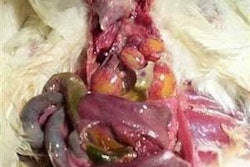For only the second time in its history, the European Union has produced more than 150 million metric tons of mixed feeds for farm animals in a single year. This was the indication from some newly updated figures for the volume of complete feeds produced in member countries of the EU-27 (see chart) when they were presented to the World Poultry 2009 conference held recently in the UK.
Pedro Corrẽa de Barros, ceo of Grupo Nutroton in Portugal and current president of European feed federation FEFAC, reported the federation’s latest estimate that EU-27 feed production in 2008 had reached some 150.6 million metric tons. This would compare with a final total of 150.3 million metric tons for 2007.
It confirms that Europe produces about as much feed annually as the USA, with each of them accounting for around 22% of a global production that FEFAC assesses as close to 685 million metric tons per year.
FEFAC analysts think the total EU demand for compound feeds in 2009 could drop by about 4% in the wake of the current international financial crisis. This would be the equivalent of losing about 6 million metric tons from the EU-27 total.
Ruminant feeds hardest hit
Ruminant feeds are expected to be hit hardest, followed by pig feed. However, the uptake of poultry feeds could be maintained this year to meet a switchover by beef and pork consumers to cheaper forms of protein while the recession continues.
The forecast from the analysts for 2009 are that Europe’s tonnage of feeds made for ruminants will drop by around 10%, mainly due to a sharp decrease in demand for dairy-cow diets at a time of historically low farmgate prices for milk. That downturn would compare with a fall expected to be about 5% for the annual production of pig feeds in EU mills, blamed on the impact of the current financial crisis. By contrast, in the poultry area a relatively stable output of broiler feeds is expected for this year and the layer-feed tonnage should also stay steady.
Pig sector takes 35%
In round terms the pig sector takes 35% of all feed manufactured industrially in the European Union, followed by poultry with a 32% share and a 26% stake for cattle. A chart produced recently by FEFAC (see Figure 1) highlighted how the addition of new member states over the last 10 years has boosted pig and poultry tonnages in particular, while the monogastric sectors’ shares of the total market have moved closer together since 2000.
More information on national feed outputs would be presented to FEFAC’s mid-year annual congress. But the revised data shown by Pedro Corrẽa de Barros made clear that France remained Europe’s biggest national feed producer in 2008, despite French volumes not changing from the 22.4 million metric tons/year recorded for 2007.
In second place, Germany grew its own tonnage from 21.3 million tons to 21.8 million tons. However, Spain dropped from 20.3 million tons to 19.2 million tons. Netherlands feed production increased from 13.7 million tons in 2007 to 14.5 million tons in 2008.
Two major countries have opposite trends
FEFAC has observed that two major EU countries have experienced opposite trends over the past years. Whereas feedmills in the Netherlands have stabilized their total volume after making almost 4 million tons less in 2003 than in 1993, Spain has gone through a phase of expansion that ended with a 1.5 million tons reduction in 2006. But Spain now rates as the largest manufacturer of pig feeds in the EU area. France leads the way in poultry feed volumes and Germany is the leading cattle feed producer.
More revealing statistically are figures from the federation for the usage of feedingstuffs at industrial mills in Europe. Table X compares the date now being reported for 2008 with rounded-up estimates from the same source for the previous year and for 1990.
Despite a big adjustment in commodity prices during the period, there is little evidence here of a significant change in the ingredients chosen by EU formulators over the past 24 months. The comparison does suggest meanwhile that co-products from the food industry are continuing to lose popularity, whereas protein cakes and meals are now used more abundantly than before. The most obvious difference between 1990 and 2008 is that the animal meals employed then as protein sources have disappeared due to BSE-related controls. Could it be that they will soon make a comeback, if the rules are altered again as has been suggested?

















